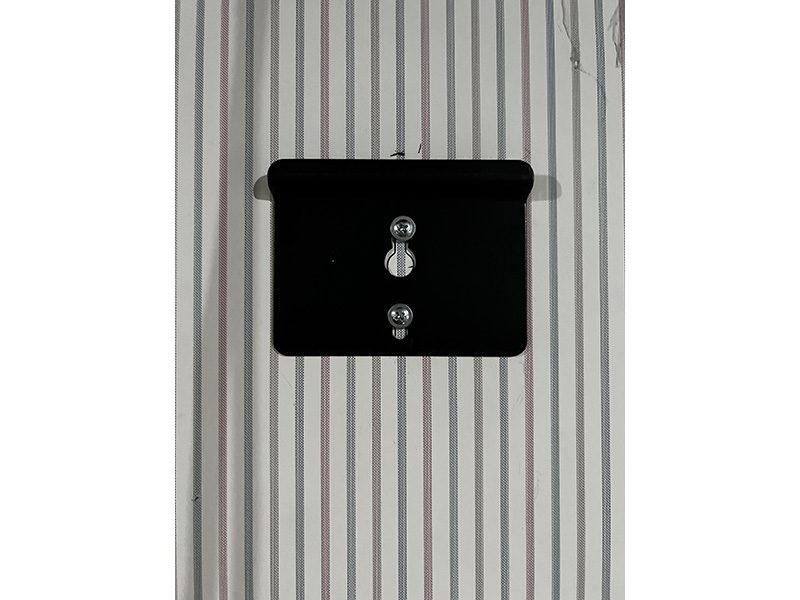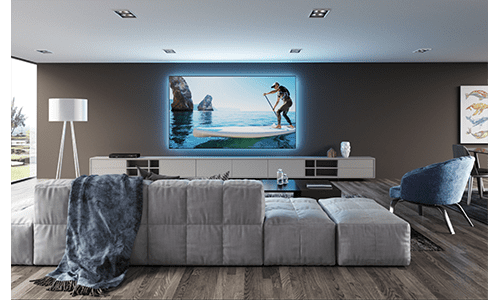For the past several decades, including since the beginning of the millennium when HD first started to make its way into the homes of AV enthusiasts, the best way to get a big-screen experience in the home meant purchasing a projection system.
Today, projection remains as the best way to bring big-screen images into the home. Over the years the technologies that have driven the big-screen experience have transitioned from CRT to solid state, and now the market is in the midst of a transition from lamp-based solutions to laser-based light engine projectors.
With the surging popularity of laser-based projectors and their benefits, which include reduced maintenance requirements, brighter images and more vivid colors, the projection category is returning to a tried-and-true projection screen solution: matte white.
Modern matte white screens aren’t your grandfather’s Oldsmobile however, and these new generation of products, highlighted by Screen Innovations’ (SI) Zero Edge Pro product with the Pure White screen material option are ushing in a new era of big-screen fun.
Sending me a Zero Edge Pro, I was able to try the screen with the Pure White 1.3 gain material.
SI Zero Edge Pro Screen Features and Setup
Arriving to my house in a single large box, SI sent along a 96-inch, 16:9 Zero Edge fixed screen model.
Explaining the technologies behind its Pure White screen materials, the company says the product employs a micro texture that is nine times as fine and smoother than a standard matte white screen.
CE Pro Features
- Innovative industrial design that complements home interior spaces
- Maximum screen size up to 205 inches in a 16:9 aspect ratio
- Maximum screen size up to 205 inches in a 2.35:1 aspect ratio
- Accessories include IR controlled backlighting and flown kit for suspending the screen from ceilings
- Some of the Zero Edge materials that are available include the 1.3 gain Pure White material and Pure Gray with 0.85 gain
- MSRP varies depending on size
SI specifies the Zero Edge Pro with Pure White 1.3’s half gain rating at 75 degrees, which the company says delivers a quality viewing experience in light-controlled rooms. SI emphasizes the screen supports resolutions as high as 8K, and the Pure White 1.3 screen material provides 10% ambient light rejection (ALR).
The company also offers the Pure White material in sizes up to 275 inches, and it also offers a choice of 16:9, 16:10, 2.35:1 and 2.40:1 aspect ratios.
Additionally, I’ll point out the Zero Edge Pro is available with other screen materials, and what I think is the major difference between the Zero Edge and the Pro version is the Pro products also come with LED backlighting to provide a more stylistic visual element to the screen, along with some image quality attributes.
Moving onto the setup of the screen. Realistically the SI screen assembly and installation is a two-person job. Working with my wife, I would estimate that it took us a couple of hours to assemble and mount the screen.
Pulling out the main frame components we read the assembly directions and identified the “boomerang” looking parts and inserted them into the frame parts’ rear channels. This allowed us to pull the frame together and then we tightened the nuts with the supplied Allen wrench to keep the frame snug. Next, we took the supplied screen snaps and fed them into the assembled frame’s other rear channels.

Continuing the assembly process, the directions state to lay the screen material across a clean, flat surface. We then aligned the female snaps that were placed into the frame channel with the male snaps that were integrated into the Pure White screen material, and we secured the screen material to the screen frame. Aligning the snaps can be trickier than it appears, but once someone gains the experience of having put a SI screen product together it shouldn’t be an issue.
Wrapping up the assembly process of the SI Zero Edge Pro screen we secured the frame’s finishing trim.
The last step was to hang the screen on the wall. Finding the center point of the wall where I was going to install the screen, I used a tape measure and level to mark out the location where I was going to screw the wall hardware to and using a drill, I quickly secured the wall mount hardware. My wife and I then simply lifted the screen onto the wall hardware and that completed the installation.

Having completed the setup and installation, I believe I could get much better with the setup process as I get more familiar with what I need to do. I’ll note that installers will need to be aware the aluminum parts can have some sharp edges, and I think that color coding the snaps would help to improve the setup process. For example, one side with red snaps, one side with white snaps, another side with black snaps and the final side with gray snaps. This would provide visual cues to help installers new to the product align the snaps correctly. I will add, putting my little snap theory aside, it’s a minor thing, and not really a big deal.
Performance and Final Thoughts
Before I get into any specifics on what I found with the Zero Edge Pro screen’s performance, I’d like to point out that aesthetically, the SI product brings a much more design-friendly element to the projection category when compared to a traditional screen product that includes the typical bezels.
Using the Zero Edge Pro screen with a Digital Projection E-Vision 4000 4K-UHD projector, I thought the combination complemented one another nicely. Initially, I tried the E-Vision 4000 with an ALR screen, and it looked nice, but through the projector’s lumen output capabilities and rich, vivid colors, I found the SI product to flesh out more of the projector’s performance capabilities.
Some of the benefits the Zero Edge Pro screen provided included higher levels of color and white brightness, and more dynamics that were highlighted with more low-level detail.

Detailing some of my experiences with the Zero Edge Pro, I’ll start by noting that normal streaming content such as Disney+’s National Geographic show, Secrets of the Zoo: Down Under, showcased the image clarity, image brightness; the color accuracy and image depth the DP, SI combination delivered.
Moreover, watching a Blu-ray version of Up, I thought it was obvious how much punchier the dynamics of the images were using the SI screen. Colors popped, contrast increased, and I would say to my eye, overall image dynamics increased when compared to the ALR screen.
Using a Dolby Atmos demonstration disc, I also checked out clips from the movie Unbroken, as well as clips such as Amazed and Leaf. My Panasonic Ultra HD disc player upsamples the resolution levels to 3820 x 2160 and I could not help but be impressed with the sharpness and highly detailed images I was seeing with the Panasonic player feeding the E-Vision 4000 and Zero Edge Pro screen.
I’d like to emphasize that as a “daily driver,” the Zero Edge Pro with the brightness capabilities of the Digital Projection E-Vision 4000 allowed me to operate with my normal, daily activities, which means I had the lights on. Sure, I lost some image quality, but it wasn’t like the old days of CRT or even some lamp-based solid-state projectors where it was pointless to have the system on.
I think this is great news from homeowners that want the best possible big-screen projection experience when the lights are off, but also desire the ability to have ambient light in their room. With the style of the Zero Edge Pro, its image quality and a nice projector like the E-Vision 4000, homeowners can get a best-case scenario for non-dedicated theater environments.
Underscoring my use of the screen as an everyday entertainment solution, I was pleasantly surprised at just how well the SI product performed with ambient light in the room. Using the Zero Edge Pro made me in fact realize, that now is really a great time to invest into some quality AV gear that doesn’t sacrifice, quality, style or performance like the Zero Edge Pro and Digital Projection products.
So, what do I think? SI is sleighing the projection screen category with a wide selection of innovative products that complement peoples’ homes and businesses, and the Texas-based company is doing it without compromising on performance.
Anyone interested in a big-screen, modern projection system absolutely needs to check out SI’s Zero Edge Pro. It combines style and performance at a reasonable price point. Summing it up … the Zero Edge Pro represents everything that homeowners should expect from a modern projection screen.
CE Pro & Cons
Pros:
- Minimalist design that will complement just about any household
- Pure White screen material provides excellent clarity, color accuracy and resolution
- The Pure White material provides versatility without sacrificing performance
Cons:
- This is a minor complaint, but the edges of the aluminum frame are sharp and potentially dangerous during the assembly process
- Color coded snaps would help expedite the securing of the screen material while assembling the screen
More news from Screen Innovations: A Converted Attic Becomes a Family-Friendly Entertainment Space







